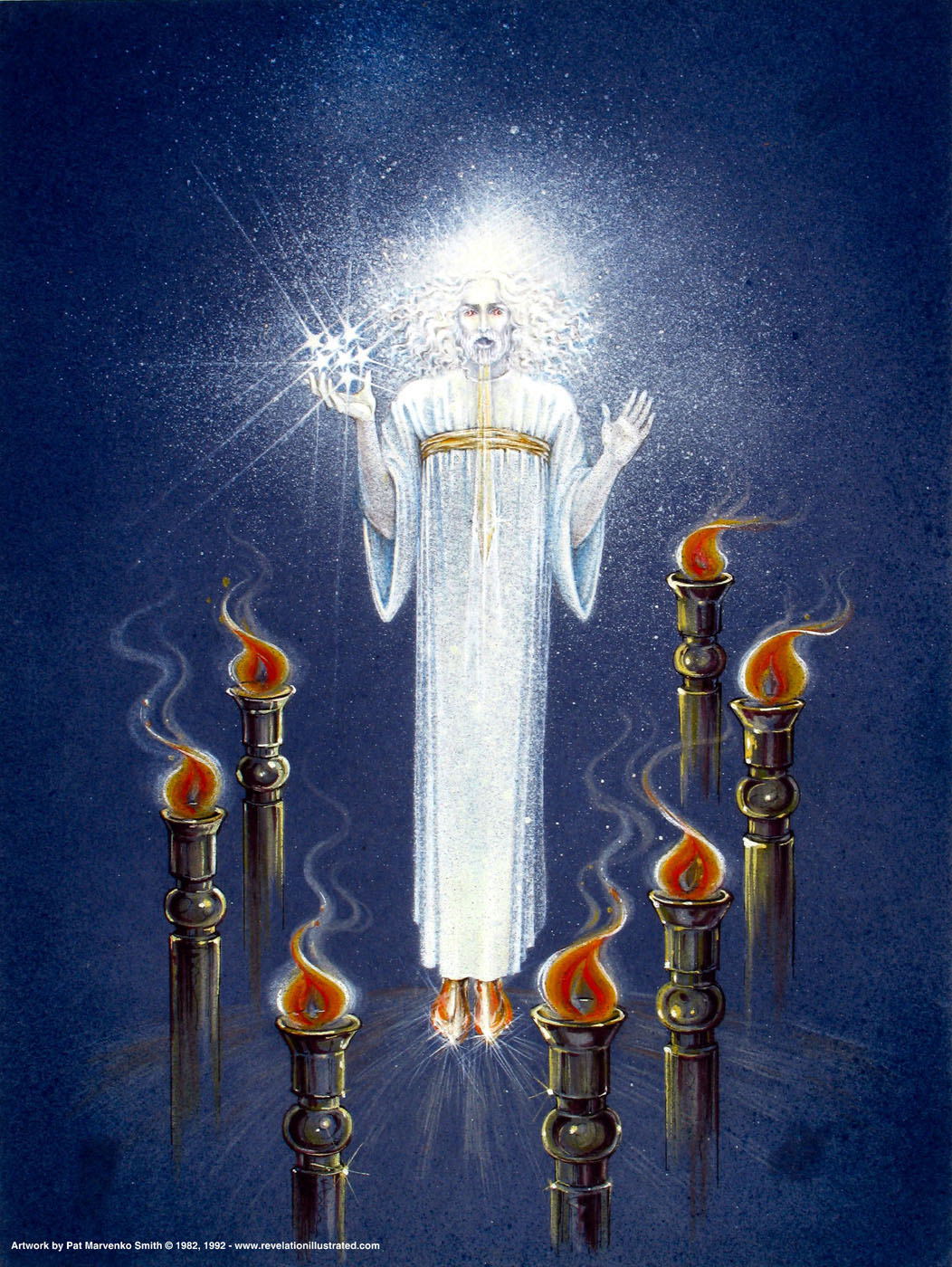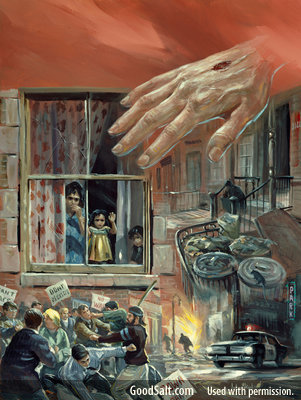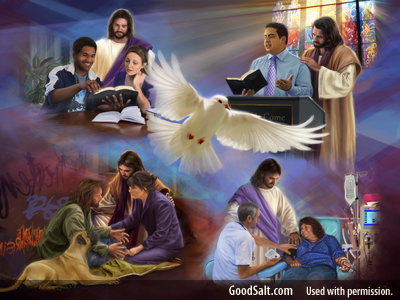“And in the midst of the seven lampstands One like the Son of Man, clothed with a garment down to the feet and girded about the chest with a golden band.” Revelation 1:13
While on the island of Patmos, the apostle John heard a trumpet-like voice instruct him to “write in a book” the visions he sees and “send” them to “the seven churches which are in Asia” Minor (1:10-11). Then he writes, “Then I turned to see the voice that spoke with me. And having turned I saw seven golden lampstands.” (Revelation 1:12). As he slowly turned toward this booming voice, the first thing John sees are “seven golden lampstands,” “each holding an oil-burning lamp.” 1 These “seven lampstands,” represent “the seven churches” (Revelation 1:20). God intended local churches to illuminate their communities with the light and life of Jesus Christ. 2
“And in the midst of the seven lampstands One like the Son of Man, clothed with a garment down to the feet and girded about the chest with a golden band.” (Revelation 1:13). John’s eyes now focus on the source of this mighty and majestic voice. Standing “in the midst of the seven lampstands” was “One like the Son of Man.” The phrase, “like the Son of Man,” is an expression used in Daniel 7:13-14 referring to the Messiah-God, the Lord Jesus Christ.3 “Son of Man” was a favorite title Jesus used of Himself in the gospels (Matthew 8:20; 9:6; 10:23; 11:19; 12:8, 32, 40; 13:41; 16:13, 27-28; 17:9, 12, 22; 18:11; 19:28; 20:18, 28; 24:27, 30, 24:37, 39; Mark 13:26; 14:21, 41, 62; et al.). This magnificent “voice” (1:10) that John heard belonged to none other than Jesus Christ, “God’s ultimate and final voice to mankind” (cf. Hebrews 1:2). 4
It is extremely noteworthy that the messianic title “Son of Man” is used here in light of the fact that it is a title connected to Jesus in His role as Judge. Jesus said, “The Father… has committed all judgment to the Son… and has given Him authority to execute judgment also, because He is the Son of Man.” (John 5:22, 27). This title portrays Jesus as “the Son” (God) and as “Man.” Christ is best qualified to judge humanity because He is the God-Man.
“Seeing Christ in His role as Judge is a key element in understanding Revelation.” 5 First, He is seen judging the seven churches in Asia Minor (Revelation 1:12-3:22) and then He is seen judging the whole earth during the Tribulation (Revelation 6-16). He will also judge Babylonianism (Revelation 17-18), world rulers at Armageddon (Revelation 19:19-21), Satan (Revelation 20:1-3, 10), the whole earth during the Millennium (Revelation 20:4-6), the rebellious earth at the end of the Millennium (Revelation 20:7-9), and all unbelievers at the Great White Throne (Revelation 20:11-15). Then King Jesus will live with His people forever on the new earth (Revelation 21-22).
John now sees Jesus in a much different way than He was portrayed in the gospels. This is not the Baby born in Bethlehem Who grew up to preach to the multitudes, heal the sick, and then suffer and die on a cross, and rise from the dead to eventually ascend to heaven. No, this depiction of Jesus is similar to when Christ was transfigured on the mountain before John, Peter, and James (Matthew 17:1-8; Mark 9:2-8; Luke 9:28-36). It was there that this apostle briefly witnessed the unveiling of Jesus’ glory. Now, near the end of John’s life, he was given a vision of the ascended Lord Jesus Christ in all His glory. 6
We learn what Jesus, the Judge, will be like as John attempts to describe His attributes using symbolism. Jesus was standing amid the churches “clothed” like a Judge with a long robe (“a garment down to the feet”) and a “golden band” around His chest. His robe is “girded” perhaps because the Judge is ready to take action (cf. Luke 12:37; Ephesians 6:14), the “golden band” “possibly foreshadowing His judgment via the golden-banded angels possessing the bowls of wrath” (cf. Revelation 15:6-7). 7
John tells us, “His head and hair were white like wool, as white as snow, and His eyes like a flame of fire.” (Revelation 1:14). “His head and hair” were very white “like wool” and “snow,” signifying His wisdom and longevity as an eternally preexistent Person like the Ancient of Days (God the Father) described in Daniel 7:9. 8 By describing “His eyes like a flame of fire,” John referred to His piercing judgment and all-seeing assessment of the saved and unsaved (cf. Revelation 2:18, 23; 19:12). 9
Next, we learn, “His feet were like fine brass, as if refined in a furnace, and His voice as the sound of many waters.” (Revelation 1:15). “His feet” looked “as if refined in a furnace,” so He could walk among the seven churches to purify and correct them (Revelation 2:1), and then trample down the unbelieving when He returns to earth (Revelation 14:19-20). “The figure of heated, glowing bronze feet also connotes strength and stability (cf. Daniel 2:33, 41).” 10 “The brass itself stands for strength, for the immovable steadfastness of God; and the shining, glittering rays stand for speed, for the swiftness of the feet of God to help His own or to punish sin.” 11
Keep in mind that John was living on the island of Patmos at this time. The sound of the ocean waves roaring and beating against the shore would never have been very far from him. 12 When John says Jesus’ “voice” sounded like the mighty rushing “waters,” this meant that the Judge’s authoritative and powerful voice conveyed irresistible orders.
“He had in His right hand seven stars, out of His mouth went a sharp two-edged sword, and His countenance was like the sun shining in its strength.” (Revelation 1:16). In Christ’s “right hand” He held “seven stars” which later He tells us represent the angelic messengers to the seven churches (Revelation 1:20). Significantly, Christ held them “in His right hand,” indicating sovereign control and possession. 13 “The hand of Christ is strong enough to uphold the heavens and gentle enough to wipe away our tears.” 14
“Out of His mouth went a sharp two-edged sword” by which His judgments are carried out (cf. Revelation 19:11-15; Hebrew 4:12). “This type of sword (rhomphaia, also referred to in 2:12, 16; 6:8; 19:15, 21) was used by the Romans in a stabbing action designed to kill. Jesus Christ was no longer a Baby in Bethlehem, or a Man of sorrows crowned with thorns. He was now the Lord of glory.” 15
“His countenance” shown like the unclouded “sun shining in its strength,” a portrait of His holiness as the Judge.“Just as the physical sun lights the earth and all its inhabitants, so also does Christ in a spiritual sense. John 8:1-11 records the divine Judge driving the adulterous woman’s accusers away because He has implicitly exposed them. Then in v 12 He calls Himself ‘the light of the world’ for the first time (a reference to the physical sun, as John 11:9 makes clear). As the Judge there is nothing at all He does not bring into the ‘sunlight’ of His countenance.” 16
These brilliant features of Jesus’ appearance all pointed to Him as God (Revelation 1:12-16)! John writes, “And when I saw Him, I fell at His feet as dead. But He laid His right hand on me, saying to me, ‘Do not be afraid; I am the First and the Last.’ ” (Revelation 1:17). Previously during Jesus’ earthly ministry, John laid His head on Jesus’ chest (John 13:25). But now when he sees Jesus’ unveiled glory as the Judge, John “fell at His feet as dead,” depleted of all his strength. This was not an encounter with another man. John was instantly reduced to a trembling sinner lying powerless before the God of the universe! 17
But in all His glory, Jesus had not lost His gentle and kind demeanor. The Lord of glory “laid His right hand on” John to console him. Then He commanded him “not [to] be afraid” because He is the eternal God (“the First and the Last”). He continued, “I am He who lives, and was dead, and behold, I am alive forevermore. Amen. And I have the keys of Hades and of Death.” (Revelation 1:18). Another reason John did not need to fear was because Jesusis the resurrected One (“I am He who lives, and was dead, and … I am alive forevermore”), Who possesses all authority over death and the dwelling of the dead (“I have the keys of Hades and of Death”). “Keys” in Scripture are symbols of authority. Therefore, those of us who believe in Jesus do not need to be afraid of hell or even the experience of death itself because Christ holds the keys. For the believer, death is a momentary experience that leads into God’s eternal presence (2 Corinthians 5:8). 18
Three times Jesus uses the words “I am” in Revelation 1:17-18. “I am” recalls Christ’s claims in the gospels (cf. Matthew 14:27; Mark 6:50; John 6:20, 35; 8:12, 58; 10:9, 14; 11:25; 14:6; 15:1) and connects Him with Yahweh in the Old Testament (Exodus 3:14; Isaiah 48:12). The title “the First and the Last” (cf. Isaiah 44:6; 48:12) is essentially the same as “the Alpha and the Omega” (Revelation 1:8), or “the Beginning and the End” (Revelation 22:13). All three titles stress the eternal sovereignty of God. 19
Jesus instructed John, “Write the things which you have seen, and the things which are, and the things which will take place after this.” (Revelation 1:19). This verse provides a divine outline of the entire book of Revelation involving the past, present, and future:
– “Write the things which you have seen.” This refers to the past vision of Jesus in all His glory (Revelation 1).
– “And the things which are.” This includes the messages to the seven churches about their present conditions (Revelation 2-3).
– “And the things which will take place after this.” This section includes the future Rapture of the Church (Revelation 4-5), the Tribulation (Revelation 6-18), the return of Christ to earth with His Church (Revelation 19), the 1000-year reign of Christ on the earth (Revelation 20:1-9), the final judgment of Satan (Revelation 20:10), the final judgment of all the unsaved (Revelation 20:11-15), and the new heaven and new earth where King Jesus will live with His people forever (Revelation 21-22).
“This outline harmonizes beautifully with the concept that most of Revelation (beginning in chap. 4) is future, not historic or merely symbolic, or simply statements of principles. It is significant that only a futuristic interpretation of Revelation 4-22 has any consistency. Interpreters following the allegorical approach to the book seldom agree among themselves on their views. This is also true of those holding to the symbolic and historical approaches.” 20
Jesus then interpreted some of the symbolic things John had seen: “The mystery of the seven stars which you saw in My right hand, and the seven golden lampstands: The seven stars are the angels of the seven churches, and the seven lampstands which you saw are the seven churches.” (Revelation 1:20). These symbols were a “mystery” or “previously unclear revelations” 21until the Lord Jesus interpreted them for John. Christ explained that “the seven stars” in His right hand “are the angels of the seven churches.” Most likely these are guardian angels over individual assemblies of believers. “Given the data in the Book of Daniel about angels being associated with individual countries (cf. Daniel 10:13, 20-21), the words of Jesus regarding angels and children (cf. Matthew 18:10), and the response to Rhoda about Peter’s angel (cf. Acts 12:15; cf. Hebrews 1:14), local churches probably have angels that guard them and represent them” (see also I Corinthians 11:10). 22
Then Christ tells John that “the seven lampstands” he saw were “the seven churches.” Christ intends for local churches to shine for Him. To do that, Christ will purify and chastise churches to make them more like Him. Otherwise, He may remove their lampstand or witness for Him (cf. Revelation 2:5). How many churches no longer exist today because they failed to repent and get right with God? I am afraid the numbers would be staggering.
“The Book of Revelation, instead of being a hopeless jumble of symbolic vision, is a carefully written record of what John saw and heard, with frequent explanations of its theological and practical meanings. Revelation, with assistance from such other symbolic books as Daniel and Ezekiel, was intended by God to be understood by careful students of the entire Word of God. Like the Book of Daniel, it will be better understood as history unfolds. Though timeless in its truth and application, it is a special comfort to those who need guidance in the days leading up to Christ’s second coming.” 23
Only Jesus Christ is qualified to judge all of humanity in the future (Revelation 1:12-20). As the Judge of all the earth, Jesus is also active among local churches today to purify them and prepare them for His return. Are you prepared to face Jesus Christ as your Judge?
The most important way to prepare to face Him is to believe in Him for His gift of everlasting life. Jesus said, “Most assuredly, I say to you, he who hears My word and believes in Him who sent Me has everlasting life, and shall not come into judgment, but has passed from death into life.” (John 5:24). Christ promises three things to those who “hear” His promise and “believe” it:
– “has everlasting life.” Notice this is present (“has”) tense. The moment a person hears and believes Jesus’ promise of eternal life, he or she “has everlasting life.” You do not have to wait until you die to enjoy eternal life. You can start to experience a personal relationship with the God of the universe forever (John 17:3) the moment you believe in Christ. You can enjoy eternal life twenty-four hours a day for three hundred sixty-five days a year! This gives Christians reason to be filled with joy all the time!
– “shall not come into judgment.” Christ guarantees you will never be judged for your sins in the future because you now have eternal life. Christ was already judged for your sins when He died in your place on a cross nearly two thousand years ago. So, there is no need for you to be judged or condemned. You are now God’s beloved child. You bring Him joy when He sees you. He is delighted to be with you.
– “has passed from death into life.” Notice that this is past tense. That means death is behind the believer, not before him. It is past, not present or future. Before we believe in Christ, we are living in the sphere of “death.” When God looks at our lives before Christ, all He sees are the evil things we have done (Isaiah 64:6). There is no hint of righteousness in us without Jesus in our lives. Our condemnation by God is total. So, when God looks at our lives before we believe in Jesus, all He sees are the bad things we have done.
But when we believe in Jesus for His gift of eternal life, we are translated into the sphere of “life.” When God looks at our lives now, He only sees the good things we have done, not the evil. How can this be? Because God has no charge against the believer (Romans 8:33). The believer is justified (“declared totally righteous”) of all things based on his or her faith alone in Christ alone (Romans 4:5). All our sin has been covered by the goodness of Jesus Christ. We are seen by God as completely holy and perfect because of His grace.
If you have believed in Jesus, then you will NOT have to face Him at the Great White Throne Judgment to determine the degree of your punishment in the lake of fire (Revelation 20:11-15). After believing in Jesus, you can face Him in the future at the Judgment Seat of Christ in heaven to determine what if any rewards you will receive from Him (Revelation 22:12; cf. 2 Corinthians 5:10). I think you will agree that this is GOOD NEWS!!!
Prayer: Lord Jesus, I am astounded by the vision John received of You in all Your glory. Words cannot adequately express the brilliance of Your holiness and majesty. Like John, all of us would fall to the ground like dead people in the presence of Your unveiled glory. You alone, Lord Jesus, are worthy to judge all of humanity in the future. Oh precious, Lord, please remove the veil that blinds the hearts and minds of those who do not believe in You for Your gift of everlasting life. Please persuade them to trust in You alone so they will not experience the same eternal judgment as Satan in the lake of fire. Use me to share the good news of Your salvation with those Your Holy Spirit has prepared to hear and believe it. Prepare me to face You as my Judge at Your judgment seat to determine what if any rewards I will receive from You. Thank You, my Lord and my God, for hearing my prayers. In Your glorious name I pray, Lord Jesus Christ. Amen.
ENDNOTES:
1. Charles R. Swindoll, Insights on Revelation, (Swindoll’s Living Insights New Testament Commentary Book 15, Tyndale House Publishers, Inc., 2014 Kindle Edition), pg. 40.
2. Tony Evans, Tony Evans, CSB Bibles by Holman. The Tony Evans Bible Commentary (B & H Publishing Group, Kindle Edition, 2019), pg. 2369.
3. John F. Walvoord, The Bible Knowledge Commentary Epistles and Prophecy, Editors John F. Walvoord and Roy B. Zuck, (David C Cook, 2018 Kindle Edition), pg. 164.
4. Bob Vacendak; Robert Wilkin; J. Bond; Gary Derickson; Brad Doskocil; Zane Hodges; Dwight Hunt; Shawn Leach. The Grace New Testament Commentary: Revised Edition (Grace Evangelical Society, Kindle Edition, 2019), pg. 1499.
5. Ibid.
6. Swindoll, pg. 40.
7. Vacendak, pg. 1499-1500.
8. Ibid., pg. 1500; Walvoord, pg. 164; cf. Tom Constable, Notes on Revelation, 2017 Edition, pg. 23.
9. Vacendak, pg. 1500; Constable, pg. 23.
10. Constable, pg. 23.
11. Ibid. cites William Barclay, The Revelation of John Vol. 1, The Daily Study Bible series (2nd ed. Edinburgh: Saint Andrew Press, 1964), pg. 62.
12. Ibid., pg. 24.
13. Ibid.; Walvoord, pg. 164.
14. Ibid., cites Barclay, pg. 63.
15. Walvoord, pg. 164.
16. Vacendak, pg. 1500.
17. Swindoll, pg. 40.
18. Vacendak, pg. 1501.
19. Constable, pg. 25.
20. Walvoord, pg. 164.
21. Constable, pg. 26.
22. Vacendak, pg. 1501.
23. Walvoord, pg. 164.










